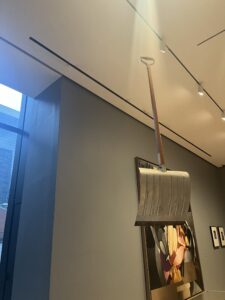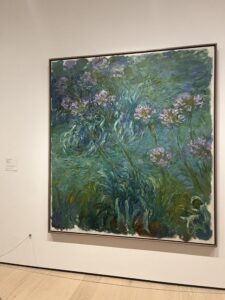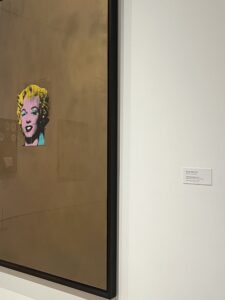On Saturday afternoon, I endured the unfortunately inconvenient commute from Staten Island to Manhattan to visit the Museum of Modern Art. Despite the travel, I was intrigued and curious as to what kind of art displays I would find, and which ones, if any, would speak or connect to me in an interesting way. As I explored the premises, I saw many paintings, sculptures, etc. that I found to be visually appealing, but I also came across pieces that initially confused me.
1: In Advance of the Broken Arm by Marcel Duchamp

When I first approached this piece, I was puzzled because from my perspective, it was just an ordinary snow shovel suspended from the ceiling. I questioned its presence in a museum of art. Upon further investigation, I found that provoking this reaction may have been a goal of Duchamp’s when deeming this piece worthy of being hung in his studio. The way I perceive it is as a direct contrast to preexisting ideas about what can truly be considered art. By giving the shovel a name that coincides with the object’s general use, without simply calling it something adjacent to “snow shovel”, this may signify that the notion of “art” is imbedded in the meaning of it rather than solely visual appeal.
2: Agapanthus by Claude Monet

While I was at the museum, this piece of art stood out to me because it looked somewhat familiar. I could not figure out where I had seen something similar before at the time. However, at home, I discovered that the paintings hanging in my house’s family room are replicas of other Claude Monet art pieces. It was particularly interesting to me that I was able to unknowingly recognize an art style that has always been present in my everyday life (they have been on our wall since before I was born) even though I do not recall ever truly taking time to study the replicas. I feel that this is significant because it shows how some notable artists have signature art styles that allow them to be identified. It was also interesting because I feel that I took more time to look at this painting than I ever have at the replicas in my home, which may just be a human tendency to observe something more closely when it is particularly put on display, or when we are told and convinced that something is important enough to be shown in a place like a museum.
3: Gold Marilyn Monroe by Andy Warhol

I found this piece interesting because I know that I have seen this image many times before. It was surprising to me that the image of Monroe herself takes up such a small amount of space on the canvas. When seeing this image replicated and shown elsewhere, especially digitally, it is easy to assume that the painted section of the piece is larger. This provoked me to think about how technology has altered society’s perception of art. Innovation such as social media has allowed art to become more accessible, which is beneficial to people who would not be able to experience certain aspects of art otherwise, but it may also be detrimental to the human experience of seeing art in person, as people may have prior expectations to seeing particularly famous art pieces that are not met when they finally physically come across them.
To my surprise, I found that my experience visiting the Museum of Modern Art did not only outlast the time that I was physically there, but was also enriched by further research and making connections between the displayed art, and aspects of my daily life and society’s preconceived ideas regarding art as a whole.


